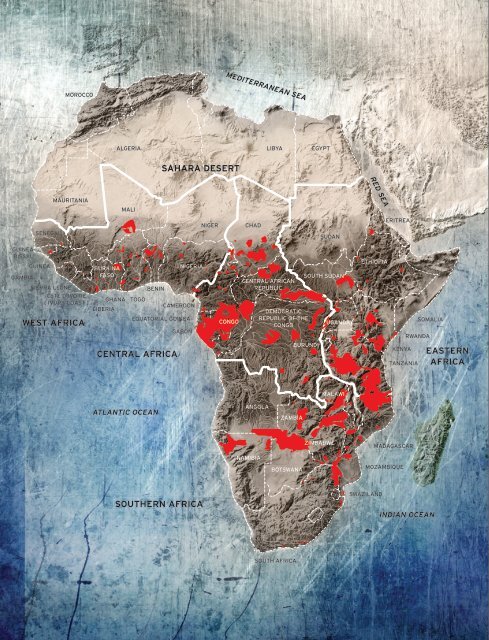ELEPHANTS & IVORY
ELEPHANTS & IVORY
ELEPHANTS & IVORY
You also want an ePaper? Increase the reach of your titles
YUMPU automatically turns print PDFs into web optimized ePapers that Google loves.
GUINEA-<br />
BISSAU<br />
GAMBIA<br />
SENEGAL<br />
GUINEA<br />
MOROCCO<br />
MAURITANIA<br />
SIERRA LEONE<br />
CôTE D’IVOIRE<br />
( <strong>IVORY</strong> COAST )<br />
WEST AFRICA<br />
BURKINA<br />
FASO<br />
LIBERIA<br />
SAHARA DESERT<br />
MEDITERRANEAN SEA<br />
ALGERIA LIBYA EGYPT<br />
MALI<br />
GHANA TOGO<br />
BENIN<br />
CENTRAL AFRICA<br />
ATLANTIC OCEAN<br />
NIGERIA<br />
CAMEROON<br />
EQUATORIAL GUINEA<br />
GABON<br />
SOUTHERN AFRICA<br />
NIGER<br />
CONGO<br />
CHAD<br />
CENTRAL AFRICAN<br />
REPUBLIC<br />
ANGOLA<br />
NAMIBIA<br />
DEMOCRATIC<br />
REPUBLIC OF THE<br />
CONGO<br />
ZAMBIA<br />
BOTSWANA<br />
SOUTH AFRICA<br />
BURUNDI<br />
SUDAN<br />
SOUTH SUDAN<br />
UGANDA<br />
MALAWI<br />
ZIMBABWE<br />
RED SEA<br />
ETHIOPIA<br />
SWAZILAND<br />
ERITREA<br />
KENYA<br />
RWANDA<br />
TANZANIA<br />
MADAGASCAR<br />
MOZAMBIQUE<br />
SOMALIA<br />
INDIAN OCEAN<br />
EASTERN<br />
AFRICA<br />
DISTRIBUTION<br />
Early in recorded human history, African elephants<br />
are said to have ranged throughout the entire<br />
African continent, from the Mediterranean Sea<br />
to South Africa, including the Sahara. Later, their<br />
distribution became limited to the sub-Saharan<br />
region. Today, their range has been further<br />
reduced to parts of West, central, eastern and<br />
southern Africa (Figure 1). 17<br />
African elephants currently exist in 37 countries<br />
(Figure 1): Angola, Benin, Botswana, Burkina Faso,<br />
Cameroon, Central African Republic, Chad, Congo,<br />
The Democratic Republic of the Congo (DRC),<br />
Côte d’Ivoire, Equatorial Guinea, Eritrea, Ethiopia,<br />
Gabon, Ghana, Guinea, Guinea-Bissau, Kenya,<br />
Liberia, Malawi, Mali, Mozambique, Namibia, Niger,<br />
Nigeria, Rwanda, Senegal, Sierra Leone, Somalia,<br />
South Africa, The Republic of South Sudan,<br />
Tanzania, Togo, Uganda, Zambia, Zimbabwe, and<br />
Swaziland (where they have been reintroduced).<br />
African elephants have been declared regionally<br />
extinct in Burundi, Gambia, and Mauritania. 18<br />
AFRICAN FOREST <strong>ELEPHANTS</strong><br />
African forest elephants inhabit the rainforests<br />
of Central Africa – the Congo basin (Cameroon,<br />
Central African Republic, Democratic Republic of<br />
Congo, Republic of Congo, Gabon and Equatorial<br />
Guinea) – and West Africa, although it has been<br />
suggested that another distinct elephant species<br />
may reside in West Africa. 19<br />
AFRICAN SAVANNA <strong>ELEPHANTS</strong><br />
African savanna elephants are said to live<br />
throughout the sub-Saharan regions of eastern,<br />
and southern Africa. 20<br />
NUMBERS OF AFRICAN <strong>ELEPHANTS</strong><br />
The most recent estimates of African elephant<br />
numbers were compiled by IUCN and published in<br />
the African Elephant Status Report 2007. 21 At that<br />
time, the total number of elephants “definitely”<br />
known was estimated as 472,269. Adding in<br />
probable, possible, and speculative estimates<br />
raised this total to 698,671 (see Appendix 2 for a<br />
summary of numbers by region and country). In<br />
reflecting on the significance of these numbers,<br />
it is sobering to realize that they are based on<br />
surveys covering only 51 per cent of presumed<br />
elephant range. Clearly, no one really knows how<br />
many elephants remain in Africa today. All we can<br />
really say is that – based on current knowledge –<br />
the number may be somewhere between 470,000<br />
and 700,000. The range of uncertainty associated<br />
with such estimates does not appear to have<br />
been quantified and the number of animals that<br />
continue to survive in the 49% of elephant range<br />
that has not been surveyed is anyone’s guess.<br />
Given the uncertainty about the precise<br />
distribution of individual African elephant species,<br />
and the uncertainty associated with current<br />
estimates of elephant numbers, it is premature to<br />
attempt individual estimates for African forest and<br />
savanna elephants.<br />
FIGURE 1 | Compiled from various sources; distribution (in red) from IUCN. 18<br />
CONSERVATION STATUS<br />
Where the conservation status of African<br />
elephants has been designated by international<br />
organizations and conventions, little attempt has<br />
been made to distinguish between species. African<br />
elephants are listed as Vulnerable on the IUCN Red<br />
List of Threatened Species. All African elephants<br />
were included in Appendix I of the Convention on<br />
International Trade in Endangered Species (CITES)<br />
in 1989. 22 Today, they remain on Appendix I, with<br />
the exception of those populations that live in<br />
Botswana, Namibia, South Africa and Zimbabwe,<br />
which are now listed on Appendix II. 23<br />
The Convention on Migratory Species (CMS)<br />
stands apart from IUCN and CITES in that it<br />
recognizes the existence of both the African<br />
savanna elephant and the African forest elephant.<br />
It includes both species on its Appendix II. 24<br />
33


